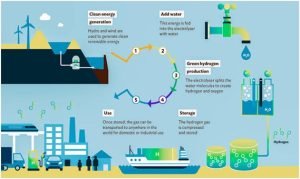Prelims – 27th Oct 23
Hydrogen as a tool to fight climate change
- Presently, hydrogen is mainly used in oil refining and the production of fertilizers. Demand for hydrogen in industrial use has more than tripled since 1975 and is currently almost completely supplied from fossil fuels according to the IEA.

- The production of “grey” (from gas) and “brown and black” (from coal) hydrogen accounts for 830 million tonnes (Mt) of CO2 a year, which is around 3% of greenhouse gas emissions.
- To reduce these emissions many countries including the US, Canada, UK, the Netherlands and Australia are currently investing heavily in blue hydrogen technology. For the long-term, using green hydrogen would significantly further reduce these emissions.
- Numerous national and regional policy targets are coming together in the global momentum towards net-zero emissions by 2050 – hydrogen is a significant part of the solutions puzzle together with renewable fuels and electrification.
- Advances in technology are making electrolysis less expensive than before, and electricity from wind, solar and hydro is much more available – meaning the production of “green hydrogen”, is now a real contender to transform the energy market.
- Green hydrogen could help end our dependence on fossil fuels and aid the transition to a net-zero world – transforming heavy-polluting industries such as steel and cement, and entering our daily lives for example in the form of hydrogen fuel cell trucks and cars.
Government e Marketplace
- GeM facilitates online procurement of common use Goods & Services required by various Government Departments / Organisations / PSUs.
- The initiative was launched in August 2016, by the Ministry of Commerce and Industry, Government of India.
- The current version of GeM, i.e., GeM 3.0 was launched on January 26, 2018.
- Public procurement amounts to 15-20% of a India’s GDP and therefore an efficiently run public procurement process is critical to our nation’s economy.
- It provides the tools of e-bidding, reverse e-auction and demand aggregation to facilitate the government users, achieve the best value for their money and aims to enhance transparency, efficiency and speed in public procurement.
What are ‘Corrupt Practices’ under the RPA, 1951?
Section 123 of the Act:
- It defines ‘corrupt practices’ to include bribery, undue influence, false information, and promotion or attempted promotion of “feelings of enmity or hatred between different classes of the citizens of India on grounds of religion, race, caste, community, or language” by a candidate for the furtherance of his prospects in the election.
Section 123 (2):
- It deals with ‘undue influence’ which it defines as “any direct or indirect interference or attempt to interfere on the part of the candidate or his agent, or of any other person, with the consent of the candidate or his election agent, with the free exercise of any electoral right.”
- This could also include threats of injury, social ostracism and expulsion from any caste or community.
Section 123 (4):
- It extends the ambit of “corrupt practices” to the intentional publication of false statements which can prejudice the outcome of the candidate’s election.
- Under the provisions of the Act, an elected representative can be disqualified if convicted of certain offences; on grounds of corrupt practices; for failing to declare election expenses; and for interests in government contracts or works.
